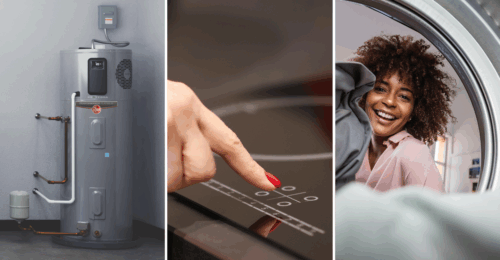Will Hudson has been part of The Home Depot team for almost two decades. Today, he is the Senior Merchant for Outdoor Portable Power and Walk Mowers. We’ve invited him to Eco Actions to talk about the transition to battery power that’s happening in the Lawn and Garden department, and what it means for the environment, homeowners and pros who shop at The Home Depot.
EA: How would you describe the change in products we are seeing in the Lawn and Garden department?

WH: We are experiencing a generational revolution in cordless tools for the Lawn and Garden space. Brands are investing millions of dollars in powerful, versatile, high-performance cordless tools for all areas of the outdoor. The performance of cordless tools can now exceed the capabilities of gas. Customers are looking for this innovation and local governments are now beginning to mandate the transition away from gas products. When an entire category improves, consumers benefit from the competition. In other words, the battery-powered equipment we have today performs better and costs the same as gas-powered alternatives.
EA: Are you saying that consumers don’t have to pay more to get the advantage of cordless?
WH: That is correct. Consumers can now go to The Home Depot and buy outdoor power equipment based on preference. Over the years, we’ve pushed suppliers to improve performance and lower costs, but this year, we are really making a statement and taking price off the table.
EA: What would you say to those people who are still on the fence when it comes to cordless? What are the benefits, and what are the barriers?
WH: The benefits are all about cleaner air, system compatibility, convenience, and better sound performance. From an environmental perspective, cordless tools have zero direct-carbon emissions. We cannot say the same about gas equipment, especially heavier duty tools like lawn mowers and backpack leaf blowers.
System compatibility is one the biggest customer benefits. When a customer enters a battery system, they are buying a battery that can power a full system of tools, often including indoor tools like drills and impact drivers. This means a customer is pre-paying for their energy and using it for indoor and outdoor projects. This is especially helpful as customers face rising gasoline prices. And as mentioned earlier, this clean energy source is now the same price as a gas-powered tool.
Cordless tools are the most convenient tools we offer at Home Depot. Consider the annual maintenance that comes with owning a gas-powered lawn mower. When I was growing up, my dad and I would take ours in every year for a tune-up. They would change the spark plugs and make sure it would run properly after sitting idle during the winter. None of that maintenance is needed with cordless. There’s no draining of old oil or fuel. There are no spark plugs and no need to buy gas. Homeowners just need to recharge and install batteries. A big chunk of hassle and cost is removed from the equation when you switch to cordless.
Noise is a big issue, too, as we can see from the growing number of local governments banning backpack leaf blowers. Not only are they a huge source of emissions, but they also contribute to noise pollution. Cordless tools can make tools quieter without sacrificing power. At RYOBI, they have found a way to put sound-dampening foam into tools. We now have a leaf blower that is one of the most powerful in the industry and also the quietest.
Because noise is becoming a bigger issue for people, we’ve started including decibel levels on our leaf blowers so that customers can see the difference and make more informed choices. I appreciate it, personally. I know that there have been times where I’ve cut the grass early in the morning while my family is still sleeping. You can’t do that with a gas mower.
Now, some people might be hesitant to transition to cordless because they think it might not have the same amount of power as gas products. This is just wrong. Like cell phones, the technology gets better each year. Before bringing products into our stores, we test our products head-to-head to understand how effective they perform for our customers. From trimmers to blowers to chainsaws and walk mowers, we now have cordless tools with more power than the gas equivalent.
Run time is another key consideration as customers must have enough battery life to complete their job. Brushless technology and battery efficiency have also improved in this area, and we are proud to publish run time on all our cordless product cards in store. We also have premium tools that include multiple batteries in a box. Ranging from two to four batteries, these tools are giving customers unlimited run time as they use one battery while charging the other.
EA: What can you tell us about where things are headed? What will we see in the next five years?
WH: The most exciting thing to me is the coming transition to battery-powered equipment at the pro level. This includes riding mowers, augers, tillers, and heavy-duty chainsaws, the likes of which no one would have considered being battery-powered five years ago. Think about tractors and zero-turn mowers, the type of equipment that pros are using to manicure a golf course. There are now cordless options for these that are as good as gas performance. That was unheard of five years ago. It just didn’t exist.
The big difference is developments in voltage. There are now high battery systems for professional equipment that can deliver hours of run time. This is big news. We’re in the midst of this transition, and we (merchants) are trying to drive that adoption as fast as we can.
EA: What else is The Home Depot doing to lead the change to cordless? Is there a future where there are no gas-powered tools in the Lawn and Garden department?
WH: It’s too soon to tell, but we’re responding to those areas that are asking for it. For 2022, we have 50 stores where we’ve removed gas handheld and walk-behind equipment. This is in places like California, Minnesota, Illinois, Washington, and Oregon where the customers are driving the adoption to cordless, not necessarily the governments. In these locations, customers are already choosing cordless over gas. So, we’ll be able to give an even broader assortment of cordless tools.
We’re interested to see where consumers go, what brands they gravitate to and what they choose. We are still stocking gas-powered tools in our Direct Fulfillment Centers, so customers who still want gas can get it delivered within 48 hours through HomeDepot.com. But this is a good litmus test on where the customers are going. It is a very exciting time to be a merchant in this space.
EA: For people who don’t know what a Merchant does, how would you describe your job?
WH: It’s definitely a jack-of-all-trades type of job. We are responsible for the end to process of determining what we sell, how much we will sell, how we are priced in the market, and how we position product in our stores. Most importantly, we are here to deliver value to our customer and drive simplicity and enthusiasm to our store associates.
I’d also say that I don’t make a single product. My job is to find the best supplier partners for The Home Depot, which means that I’m looking for suppliers that will keep us in stock, offer innovation, offer value to customers, and are operating responsibly and sustainably.






